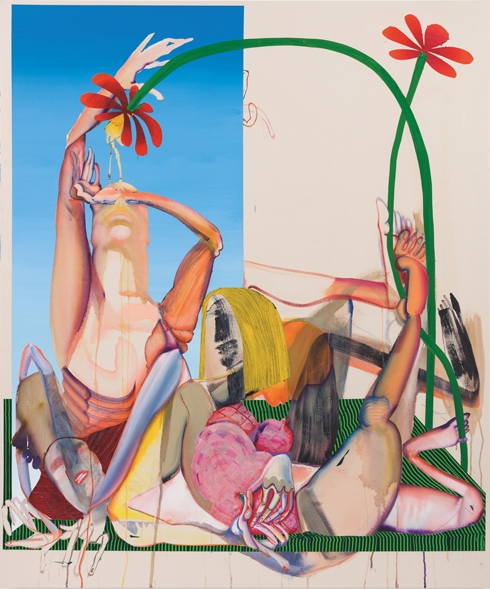The figures that Christina Quarles begins by drawing straight to canvas are a fragmented, refracted, everchanging jumble. These outlines are fleshed out into painted limbs that stretch and twist with a soft spaghetti ease: boobs dangle or jut at right angles while butt cheeks bloom into radiant red suns. Skin dissolves into ribs, muscle and guts. Faces are rarely more than spectral smudges, but there’s a particular emphasis on heavily outlined, cartoonish hands and feet: the ends of our bodies most clearly visible to ourselves. These are nudes conjured from the inside out.
The immediate impression in the Los Angeles-based painter’s first institutional show in the UK is of categories collapsing in an orgy of body parts. Quarles’s titles both reinforce and undermine this, playing on the slippages in puns and misapprehensions like Carefully Taut (2019), Let Us In Too (Tha Light) (2018) or By Tha Skin of Our Tooth (2019), with its muddle of singular and plural, and bleed between flesh and bone. The ecstatic blurring of Quarles’s paintings is underpinned by the artist’s experience as the light-skinned, queer, cis-gendered daughter of a black father and white mother, with all of the readings and misreadings of her identity that entails.
Set against brash, upbeat chequerboard, harlequin, dogtooth and spotty 2D backgrounds, Quarles’s bodies are cut up and interrupted by abruptly shifting planes and perspectives. Cut to Ribbons (2019), for instance, references the swimming pool paintings of David Hockney, a selection of whose work from the 1960s can be seen in the adjoining galleries. Slicing across what could be a many-limbed single figure or two embracing bodies with one head are three planes of blue: a solid bold bar of acrylic, an expressive wash and finally the twirling white-on-blue ribbons familiar from Hockney.
If the anything-goes physicality of Quarles’s figures suggests freedom, the world they inhabit has clear zones and boundaries, not least the edge of the canvas itself, against which they often lean or push. It’s also a world that draws attention to its own construction, with Quarles using contrasting painterly techniques and references to establish her own hybrid art-historical lineage. Textured brushstrokes, thick smooth skins of shiny paint, stencilled patterns and airy spray coexist in a single painting, or figure. Nods to other artists stack up, from the young Hockney’s knowing play with abstraction and figuration to Maria Lassnig’s body-focused self-portraits.
Quarles turns the push-and-pull between liberated queer subjectivity and externally imposed norms into an entanglement of bodies and environments. This tension between how we create ourselves and how others shape us, independence and dependence, affects the relationships between the figures themselves, too. In her delicate, droll line drawings, lovers with mingling outlines pine for one another (‘aint no sunshine when she gone’ reads the writing on one midriff) while attempting to establish boundaries. Hold Up (2019), for example, evokes both the setting of limits (I need my space!) and mutual support. It’s a contradiction that speaks to how identity is formed and maintained, which Quarles articulates with wit and insight.
Christina Quarles at Hepworth Wakefield, 19 October – 19 January
From the December 2019 issue of ArtReview
